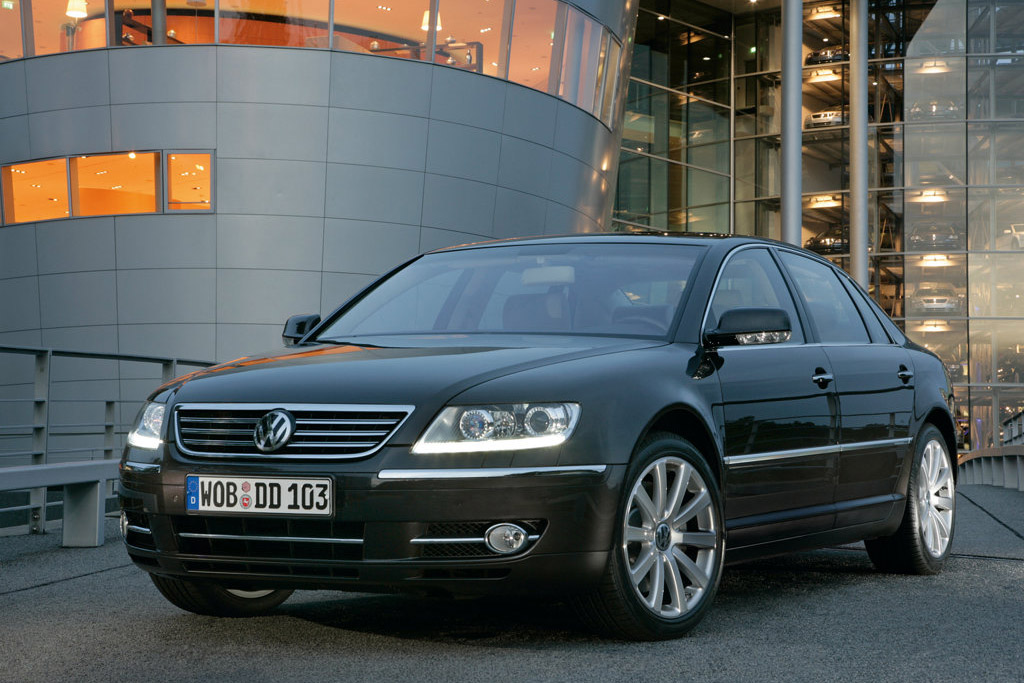The name Phaeton derives from Phaëton, the son of Phoebus (or Helios) in Greek mythology, by way of the phaeton auto body style and the type of horse-drawn carriage that preceded it.
* 1 Overview
* 2 Features
* 3 Sales
* 4 Powertrain
* 5 2009 and 2011 Phaeton Facelifts
o 5.1 New technologies
* 6 References
* 7 External links
The Phaeton was conceived by Ferdinand Piëch, the then chairman of Volkswagen Group. Piëch wanted Volkswagen engineers to create a car that would overwhelmingly surpass the German prestige market leaders, Mercedes-Benz and BMW. The decision to release the Phaeton was, in part, a response to Mercedes's decision to compete directly with Volkswagen in the European marketplace with the low-cost A-Class. It was also intended to support the Volkswagen brand image, since the most expensive versions of lesser models, such as the Golf GTI, were starting to cost almost as much as equivalently-sized prestige brands. Although the Volkswagen group already has a direct competitor in the full-sized luxury segment, the Audi A8, the Phaeton is intended to be more of a limousine like the Mercedes-Benz S-Class, while the A8 and BMW 7 Series are more sport-oriented
Initial development of the Phaeton, given the internal project code VW611, began with Piëch giving his engineers a list of ten parameters the car needed to fulfill. Most of these specifications were not made known to the public, but a number of them were told to automotive reporters. One of them was that the Phaeton should be capable of being driven all day at 300 kilometres per hour (186 mph) with an exterior temperature of 50 °C (122 °F) whilst maintaining the interior temperature at 22 °C (72 °F).[4] Piëch requested this even though the Phaeton's top speed was electronically limited to 250 kilometres per hour (155.3 mph) Another requirement was that the car should possess torsional rigidity of 37,000 N·m/degree.
The Phaeton's platform, the Volkswagen Group D1 platform, is shared with the Bentley Continental GT and Bentley Continental Flying Spur. Certain systems, such as the automatic transmission and some engines, are also shared with the Audi A8. The D1 is a stand-alone steel platform, and was specifically developed for the Phaeton and Bentley Continental. It is commonly confused with Audi's D3 platform, which is an all-aluminium-based, instead of the D1's steel platform.
As of 2010[update], the Phaeton has the longest wheelbase in the Volkswagen Passenger Car line.
The Phaeton is hand-assembled in an eco-friendly factory with a glass exterior, the Transparent Factory (German: Gläserne Manufaktur) in Dresden, Germany. This factory also assembled Bentley Continental Flying Spur vehicles destined for the European market until October 2006, when all assembly of the Bentley products was transferred to Crewe, England.
The Phaeton body is fabricated and painted at the large Volkswagen works at Zwickau, Germany, and the completed bodies are then transported about 100 km by special road transport vehicles to the Transparent Factory. Most Phaeton engines, the W12 being the notable exception, are built at the VW/Porsche/Audi engine plant in Győr, Hungary.
 Volkswagen Phaeton
Volkswagen Phaeton Volkswagen Phaeton
Volkswagen Phaeton Volkswagen Phaeton
Volkswagen Phaeton Volkswagen Phaeton
Volkswagen Phaeton Volkswagen Phaeton
Volkswagen Phaeton Volkswagen Phaeton
Volkswagen Phaeton Volkswagen Phaeton
Volkswagen Phaeton Volkswagen Phaeton
Volkswagen Phaeton Volkswagen Phaeton
Volkswagen Phaeton
No comments:
Post a Comment